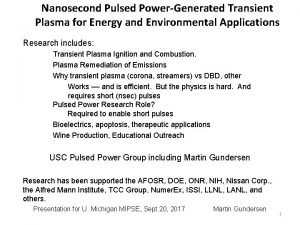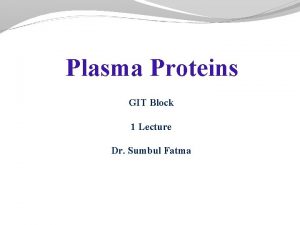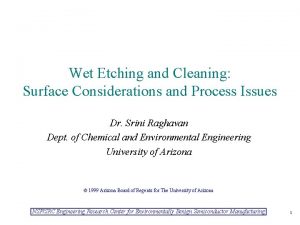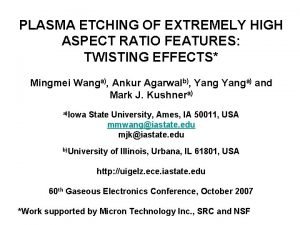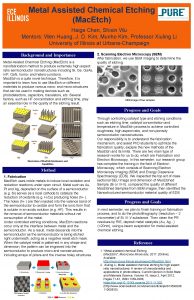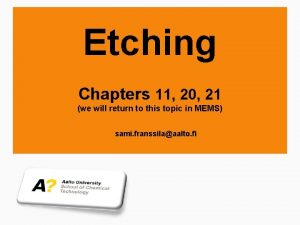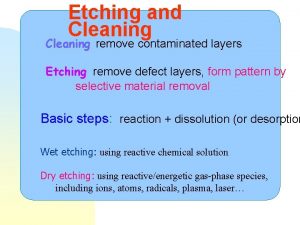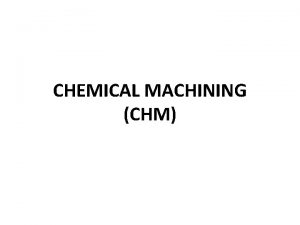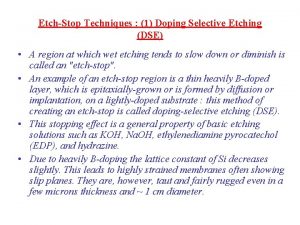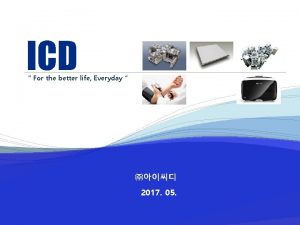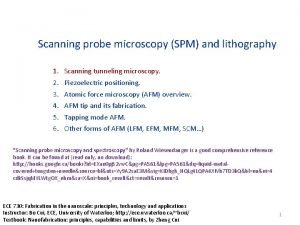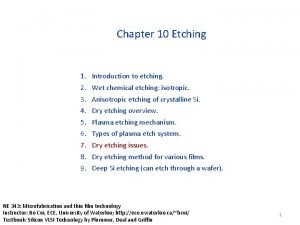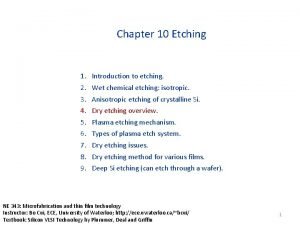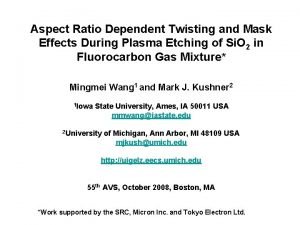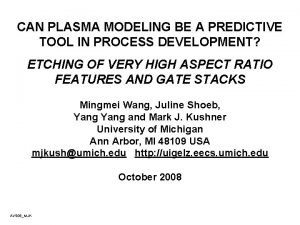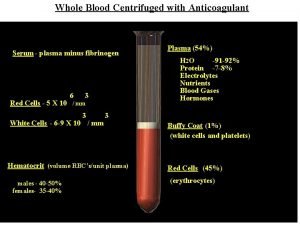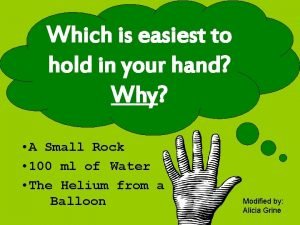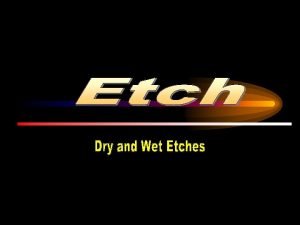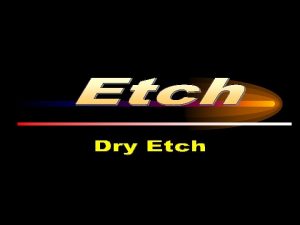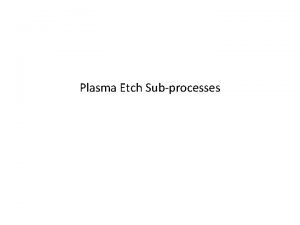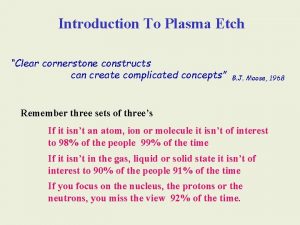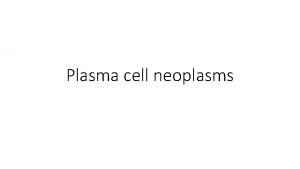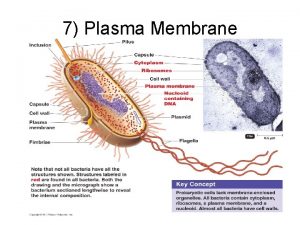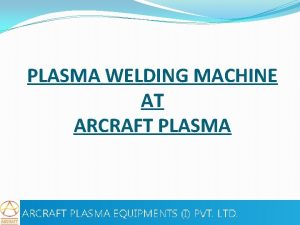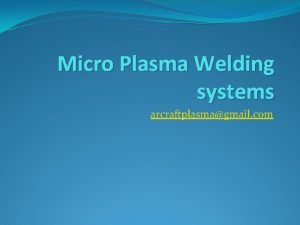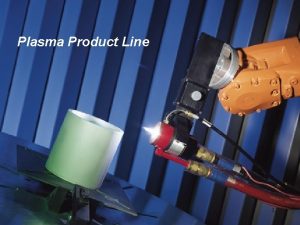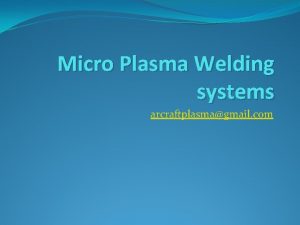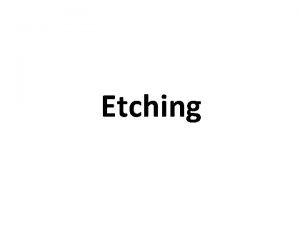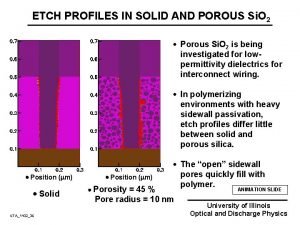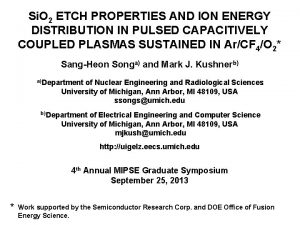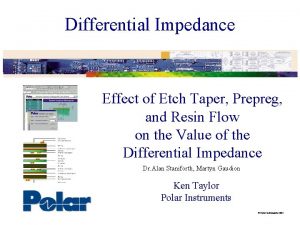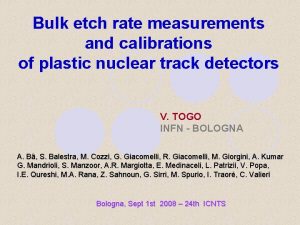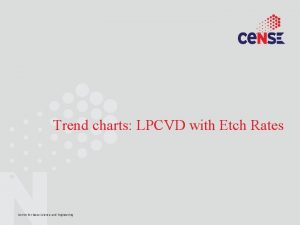Etch Systems I Types of Etch Systems Plasma



















- Slides: 19

Etch Systems (I)

Types of Etch Systems • Plasma etch reactors can be grouped into three broad groups: 1. Sputter etch – physical process, etches by ion bombardment only, uses a non-reacting gas, it is anisotropic and non-selective 2. Chemical etch – chemical process, specially selected gases to react with materials, ion bombardment is negligible, it is isotropic and selective 3. Combined etch – ion bombardment complements chemical etch, varies from isotropic to anisotropic with fair selectivity

Plasma Etch Systems • The term plasma etch systems can refer to any system that uses plasma generation in order to etch a sample • A sample can be biased to improve bombardment’s effect on the etching. This is call Reactive Ion Etching (RIE) • A sample can be left unbiased which takes way much of the effects of bombardment, leaving chemistry as the dominant etching force. This is known as Plasma Etch (PE)

Etch Systems • • • Horizontal Plate RIE Parallel Plate Etch Microwave Etch Electron Cyclotron Resonance (ECR) Etch Hexode RIE MERIE Inductively Coupled Plasma (ICP) Etch Ion Beam Etch Advanced Strip and Passivation (ASP)

Horizontal Plate RIE • The substrate is placed on a powered cathode • The cathode is generally water-cooled to remove the heat generated by ion bombardment. • Chamber walls usually function as the anode, and may also be temperature controlled.

Generic Parallel Plate Plasma Model The majority of the plasma body consists of etch gas molecules, etch by-product molecules and radicals. A typically low density plasma consists of less than 1% charged species. Positive Ions Electrons Neutral Atoms and Molecules Public Domain: Image Generated by CNEU Molecular Fragments Staff for free use, 2009.

Simple Diagram of a Horizontal Plate RIE Ion drawn to negatively charged cathode 50 Ω Impedance Match ~ Public Domain: Image Generated by CNEU Staff for free use, 2009.

Typical Horizontal Plate Reactive Ion Etch System MFC’s Vent/Purge Ion Gauge Capacitance Manometer for throttle valve control TC 1 Cathode with backside cooling CF 4 Roughing Valve N 2 Typical Gases Throttle Valve Impedance Match Turbo Pump - C Blocking Capacitor TC 2 13. 56 MHz RF Power Source O 2 Foreline Valve Public Domain: Image Generated by CNEU Staff for free use, 2009. Scrubber Mechanical Pump - C

Simple Diagram of a Parallel Plate (Planar) 50 Ω Impedance Match Ion not directed to substrate ~ Short around capacitor Public Domain: Image Generated by CNEU Staff for free use, 2009.

Microwave Etch • Plasma is formed in a tuned microwave cavity remotely located from the etch chamber • A UV light source may be used to ignite the plasma • Active gas species flow through a showerhead into the etch chamber • Heaters are generally used to increase the rate for photoresist ashing • This system is often called a down stream asher

Microwave Etch Plasma is Generated “Out of Sight” of the substrate. 2. 45 GHz Power supply MFC’s Tuning Stubs Vent/Purge Baffling: blocks line of sight TC 1 He Ion Gauge IR Substrate Heating Lamp Roughing Valve O 2 N 2 Typical Gasses Capacitance Manometer for throttle valve control Throttle Valve Turbo Pump - C TC 2 Foreline Valve Public Domain: Image Generated by CNEU Staff for free use, 2009. Mechanical Pump - C

Electron Cyclotron Resonance Etch (ECR) • ECR uses lower pressures than a conventional parallel plate RIE to be able to achieve cyclotron resonance. Lower pressures offer these advantages: – Reduced particles – Reduced residues and contamination – More inherent anisotropy • The disadvantages are: – More damage due to increased MFP – Less chemistry – Difficult to achieve a uniform plasma greater than 6 inch diameter

Electron Cyclotron Resonance Etch (ECR) • The design provides a high ion density at low pressure to more effectively transfer energy to the free electrons and at the same time keep them in the plasma region longer.

Electron Cyclotron Resonance Etch (ECR) • A magnetic field parallel to the direction of the flow causes the free electrons to travel in a spiral path. • The frequency an electron travels around the spiral is determined by the magnetic flux density. • Maximum energy can be transferred when the frequency of electrons spiraling around magnetic flux line (electron cyclotron frequency) is equal to the frequency of applied electric field.

Electron Cyclotron Resonance Etch (ECR) • Additional magnets may surround the substrate area to aid in plasma uniformity • Relatively high bombardment damage and inability to etch substrates larger than 150 mm generally make this technically obsolete.

Typical ECR Etch System 2. 45 GHz Power supply Wave Guide Tuning Stubs Ion Gauge Capacitance Manometer for throttle valve control Impedance Match Blocking Capacitor Optional 13. 56 MHz RF Power Source Magnets 873 Gauss MFC’s Wave Guide Window Vent/Purge TC 1 Cathode with backside cooling Steering Magnets CF 4 Roughing Valve O 2 N 2 Typical Gasses Throttle Valve Scrubber Turbo Pump - C Mechanical Pump - C TC 2 Foreline Valve Public Domain: Image Generated by CNEU Staff for free use, 2009.

Hexode RIE • This is a batch type RIE. • This system holds substrates vertically on the six -sided cathode. • The chamber walls are grounded to act as the anode. • Let’s discuss the design, and how this would impact the recipe, and material processing…. .

Hexode RIE MFC’s Anode Vent/Purge Hexode (Cathode) Typical Gases TC 1 He Substrates Roughing Valve O 2 N 2 Blocking Capacitor 13. 56 MHz RF Power Source Impedance Match Capacitance Manometer for throttle valve control Throttle Valve Turbo Pump - C TC 2 Mechanical Pump - C Foreline Valve Public Domain: Image Generated by CNEU Staff for free use, 2009.

Hexode RIE • The hexode system is often used for isotropic processes. • Pressure is relatively high, in the 100’s m. T range to provide high concentration of chemical reactants • DC bias is minimal due to the high pressure and large cathode
 Transient plasma
Transient plasma Types of plasma
Types of plasma Etchant
Etchant Etching cleaning process
Etching cleaning process High aspect ratio contact
High aspect ratio contact Mac etch
Mac etch Microfabrication
Microfabrication Etch undercut
Etch undercut Maskants and etchants
Maskants and etchants Acid restoration vin
Acid restoration vin The use of acid to etch the obliterated serial number.
The use of acid to etch the obliterated serial number. Etch stop techniques
Etch stop techniques Etch 공정
Etch 공정 Scanning probe microscopy applications
Scanning probe microscopy applications Etch rate
Etch rate Dry etch
Dry etch Harc etching
Harc etching Harc etch
Harc etch Blood plasma minus fibrinogen is
Blood plasma minus fibrinogen is Solid+heat=
Solid+heat=
